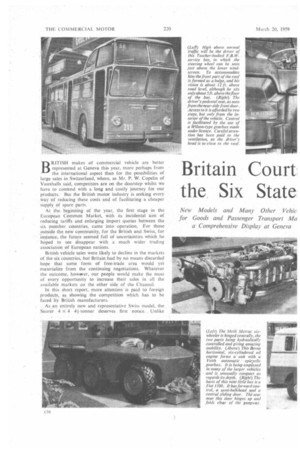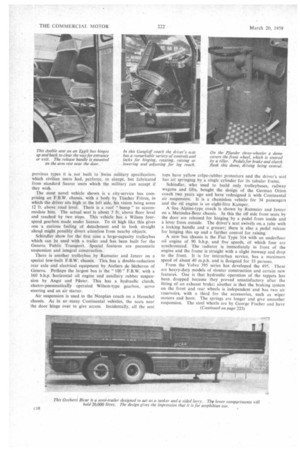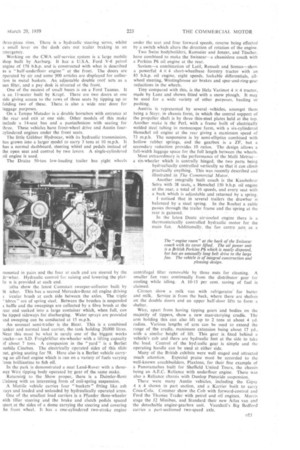Britain Court the Six State
Page 54

Page 56

Page 61

If you've noticed an error in this article please click here to report it so we can fix it.
New Models and Many Other Vehic, for Goods and Passenger Transport Ma a Comprehensive Displayat Geneva BRITISH makes of commercial vehicle are better represented at .Geneva this year, more perhaps from the international aspect than for the possibilities of large sales in Switzerland, where, as Mr. P. W. Copelin of Vauxhalls said, competitors are on the doorstep whilst we have to contend with a long and costly journey for our products. But the British motor industry is seeking every way of reducing these costs and of facilitating a cheaper supply of spare parts.
At the beginning of the year, the first stage in the European Common Market, with its incidental aim of reducing tariffs and enlarging import quotas between the six member countries, came into operation. For those outside the new community, for the British and Swiss, for instance,, the future seemed full of uncertainties which he hoped to see disappear with a much wider trading association of European nations.
British vehicle sales were likely to decline in the markets of the six countries, but Britain.had by no means discarded hope that some form of free-trade area would yet Materialize from the continuing negotiations. Whatever the outcome, howaver, our people would make the most of every opportunity to increase their sales in all the available markets on the other side of the Channel.
In this short report, more attention Is paid to foreign products, as showing the competition which has to be faced by British manufacturers.
. As,an entirely new and representative Swiss model, the Saurer 4 X 4 41-tonner deserves first notice. Unlike
previous types it is not built to Swiss military specification, which civilian users had, perforce, to accept, but fabricated from standard Saurer units which the military can accept if they wish.
The most novel vehicle shown is a city-service bus comprising an F.B.W. chassis, with a body by Ttiscl3er Freres, in which the driver sits high at the left side, his vision being some 12 ft. above road level. There is a roof "bump" to accommodate him. The actual seat is about 5 ft. above floor level and reached by two steps. This vehicle has a Wilson fourspeed gearbox made under licence. To sit high like this gives one a curious feeling of detachment and to look straight ahead might possibly divert attention from nearby objects.
Schindler show for the first time a large-capacity trolleybus which can be used with a trailer and has been built for the Geneva Public Transport. Special features are pneumatic suspension and integral construction.
There is another trolleybus by Ramseier and Jenzer on a special low-built F.B.W. chassis. This has a double-reduction rear axle and electrical equipment by Ateliers de Secheron of Geneva. Perhaps the largest bus is the "100" F.B.W. with a 160 b.h.p. horizontal oil engine and auxiliary rubber suspension by Angst and Pester. This has a hydraulic clutch, electro-pneumatically operated Wilson-type gearbox, servo steering and an air starter.
Air suspension is used in the Neoplan coach on a Henschel chassis. As in so .many Continental vehicles, the seats near the door hinge over to give access. :Incidentally, all the seat
tops have yellow crêpe-rubber protectors and the driver's seat has air springing by a single cylinder for its tubular frame.
Schindler, who used to build only trolleybuses, railway wagons and lifts, bought the design of the German Orion coach two years ago and have redesigned it with Continental air suspension. It is a chassisless vehicle for 34 passengers and the oil engine is an eight-litre Kamper.
A fine Alpine-type coach is shown by Ramseier and Jenzer on a Mercedes-Benz chassis. In this the off side front seats by the door are released for hinging by a pedal from inside and a lever from outside. The driver's seat swivels on.a tube with a locking handle and a greaser; there is also a pedal release for hinging this up and a further control for raising.
A new bus chassis is the Fiat Type 314 with an underfloor oil engine of 90 b.h.p. and five speeds, of which four are synchronized. The radiator is immediately in front of the engine and the frame is straight with a slight insweep and drop to the front. It is for interurban service, has a maximum speed of about 40 m.p.h. and is designed for 33 persons.
From the Volvo 395 series has developed the 495. These are heavy-duty models of stouter construction and certain new features. One is that hydraulic operation of the tappets has been dropped because they proved unsatisfactory after the fitting of an exhaust brake; another is that the braking system on the front and rear wheels is independent and has two air reservoirs, with a third for the accessories, such as wiper motors and horn. The springs are longer and give smoother suspension. The steel wheels are by George Fischer and have three-piece rims. There is a hydraulic •steering servo, whilst a small lever on the dash cuts out trailer braking in an :mergency.
Working on the CWA self-service system is a large mobile shop built by Aarburg. It has a U.S.A. Ford V-8 petrol engine of 178 b.h.p. and is constructed with what is described as a "half-underfloor engine" at the front. The doors are operated by air and some yoo articles are displayed for collection in metal baskets. An adjustable double roof acts as a sun filter, and a pay desk is situated at the front.
One of the neatest of small buses is on a Ford Taunus. It ts an. 11-seater built by Krapf. There are two doors at one side giving access to the rows of three seats by tipping up or folding two of these. There is also a wide rear door for luggage purposes.
On a Tempo Matador is a double horsebox with entrance at the rear and exit at one side. Other models of this make include a 14-seat bus and a pantechnicon with seating for three. These vehicles have front-wheel drive and Austin four:ylindered engines under the front seats. The little Gtildner Hydrocar, with its hydraulic transmission, has grown into a larger model to carry 3 tons at 10 m.p.h. It has a normal dashboard, steering wheel and pedals instead of the open seat and control by two levers A single-cylindered oil engine is used. The Draize 50-ton low-loading trailer has eight wheels mounted in pairs and the four at each end are steered by the irwbar. Hydraulic control for raising and lowering the platn is provided at each end. :olba show the latest Cannstatt sweeper-collector built by .icher. This has a second Mercedes-Benz oil engine driving ircular brush at each side between the axles. The triple ' hbres" are of spring steel. Between the brushes is suspended t baffle and the sweepings are collected by a fibre brush at the rear and sucked into a large container which, when full, can be tipped sideways for discharging. Water sprays are provided Ind sweeping can be conducted at 15 m.p.h. An unusual semi-trailer is the Bicar. This is a combined tanker and normal load carrier, the tank holding 20,000 litres. Near this must be what is surely one of the biggest works trucks—an S.D. Freightlifter six-wheeler with a lifting capacity of about 7 tons. A companion in the "yard" is a Berliet rnobile Cinebus. The electrically operated sides of this slide out, giving seating for 58. Here also is a Berliet vehicle carryng an all-fuel engine which is run on a variety of fuels varying 'rom brilliantine to fish oil, In the park is demonstrated a neat Land-Rover with a threeway Wirz tipping body operated by gear of the same make.
Returnint to the Show proper, there is a Daimler-Benz ijnimog with an interesting form of coil-spring suspension.
A Mattile vehicle carries four "buckets" fitting like ash rays and loaded and unloaded by hydraulically operated arms. One of the smallest load carriers is a Kander three-wheeler with tiller steering and the brake and clutch pedals spaced part at the sides of a dome carrying the steering and covering he front wheel. It has ;1 one-cylindered two-stroke engine under the scat and four forward speeds, reverse being effected by a switch which alters the direction of rotation of the engine.
Two Swiss bodybuilders, Ramseier and Jenzer, and Tascher, have combined to make the Swisscar—a chassisless coach with a Perkins P6 oil engine at the rear.
Saviem—a combination of La tit, Renault and Somua—show, a powerful 4 X 4 short-wheelbase forestry tractor with an 85 b.h.p. oil engine, eight speeds, lockable differentials, allwheel steering. Westinghouse air brakes and spur-and-ring-gear reductions in the wheels.
Tiny compared with this, is the Hela Varimot 4 x 4 tractor, made by Lanz and shown fitted with a snow plough. It may be used for a wide variety of other purposes, hauling or pushing.
Austria is represented by several -vehicles, amongst them being a Steyr, in chassis form, in which the central support of the propeller shaft is by three thin-steel plates held at the top. Another make is the Pert, with a frame built of electrically welded steel tubing in monocoque form, with a six-cylindered Henschel nil engine at the reaf giving a maximum speed of 73 m.p.h. The suspension is by semi-elliptics combined with hollow rubber springs, and the gearbox is a ZF, but a secondary reduction provides 10 ratios. The design allows a full-width luggage space for the full length between the wheels.
Most extraordinary is the performance of the Meili Metraca six-wheeler which is centrally hinged, the two parts being hydratffically controlled vertically so that it can climb practically anything. This was recently described and illustrated in The Commercial Motor.
Another integrally built coach is the KassbohrtaSetra with 38 Seats,. a Henschel 150 b.h.p. oil engine at the sear, a total of 10 speeds, and every seat with a back which is adjustable and returned by a spring.
I noticed that in several trailers the drawbar is balanced by a steel spring. In the Rochat a cable passes through the trailer frame and the spring at the rear is gaitered.
In the latest Deutz air-cooled engine there is a thermostatically controlled hydraulic motor for the main fan. Additionally, the fan centre ,acts as a centrifugal filter removable by three nuts for cleaning. A smaller fan runs continually from the distributor gear for cooling while idling. A 10-15 per cent, saving of fuel is claimed.
Citroen show a milk van with refrigerator for butter and milk. Service is from the back, where there are shelves on the double doors and an upper half-door lifts to form a shelter.
Wirz, apart from having tipping gears and bodies on the majority of tippers, show a new man-carrying cradle. The arm holding this can also lift up to 2 tons at about 4 yd. radius. Various lengths of arm can be used to extend the range of the cradle, maximum extension being about 17 yd., with a similar height of lift. This gear is, fixed behind a vehicle's cab and there are hydraulic feet at the side to take the load. Control of the hydfaulic gear is simple and the operating handle can be used at either side.
Many of the British exhibits were well staged and attracted much attention. Especial praise must be accorded to the well-known coachbuilders, Plaxtons, for their fine example of a Panoramabus built for Sheffield United Tours, the chassis being an A.E.C. Reliance with underfloor engine. There was also a Reliance chassis with Dunlop Pneuride suspension.
There were many Austin vehicles, including the Gipsy 4 x 4 shown in part section, and a Karrier built to carry Coca-Cola. Commer show the Cob with forward-control and Ford the Thames Trader with petrol and oil engines. Morris stage the J2 Minibus, and Standard their new Atlas van and the detachable engine-gearbox unit. Vauxhall's Big Bedford carries a part-sectioned two-speed axle.












































































































